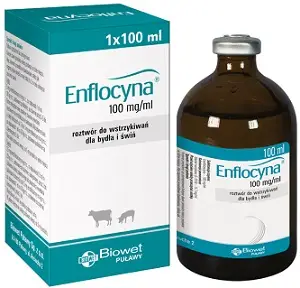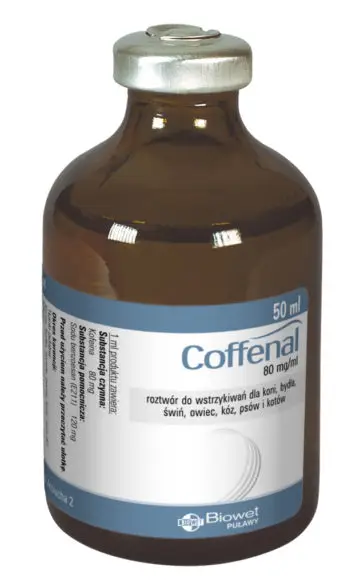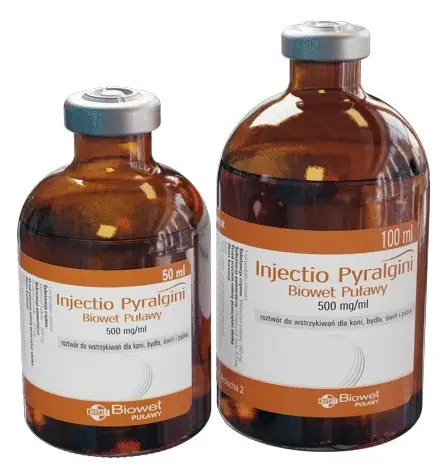Description
Enflocyna 100 mg/ml, solution for injection for cattle and pigs
Statement of the active substance(s) and other ingredient(s)
Each ml contains:
Active substance:
Enrofloxacin – 100 mg
Excipient:
Benzyl alcohol (E-1519) – 157 mg
Clear, slightly yellow solution.
Target species
Cattle, pigs.
Indications for use
Cattle
Treatment of respiratory infections caused by Pasteurella multocida, Mannheimia haemolytica and Mycoplasma spp. susceptible to enrofloxacin.
Treatment of gastrointestinal infections caused by Escherichia coli susceptible to enrofloxacin.
Treatment of septicaemia caused by Escherichia coli susceptible to enrofloxacin.
Treatment of acute mycoplasma arthritis caused by Mycoplasma bovis susceptible to enrofloxacin in cattle less than 2 years of age.
Pigs
Treatment of respiratory infections caused by Pasteurella multocida, Mycoplasma spp. and Actinobacillus pleuropneumoniae susceptible to enrofloxacin.
Treatment of urinary infections caused by Escherichia coli susceptible to enrofloxacin.
Treatment of Postpartum Dysgalactia Syndrome – PDS (Metritis Mastitis Agalactia MMA) caused by Escherichia coli and Klebsiella spp. susceptible to enrofloxacin.
Treatment of gastrointestinal infections caused by Escherichia coli susceptible to enrofloxacin.
Treatment of septicaemia caused by Escherichia coli susceptible to enrofloxacin.
Contraindications
Do not use as a preventive measure.
Do not use in case of known cross-resistance to fluoroquinolones or quinolones.
Do not use in case of hypersensitivity to the active substance or to any of the excipients.
Do not use in growing horses due to the risk of joint cartilage damage.
Special warnings
Special precautions for safe use in the target species:
Degenerative changes in joint cartilage were observed in calves treated with 30 mg of enrofloxacin per kg body weight, administered per os for 14 days.
Principles of prudent use:
If possible, fluoroquinolones should be used based on results of antimicrobial resistance testing.
During product use, comply with the applicable national and local guidelines for using antimicrobial drugs.
Fluoroquinolones should be used in treating only those diseases in which observed response to administration of other classes of antimicrobial drugs is not satisfactory or the response to treatment is expected to be insufficient.
Using the product contrary to provisions of the Summary of Product Characteristics may lead to increased frequency of microbial resistance to fluoroquinolones and decreased efficacy of treatment using other quinolones due to emergence of a potential cross-resistance.
Special precautions to be taken by the person administering the veterinary medicinal product to animals:
In case of accidental self-injection, seek medical advice immediately and show the package leaflet or the label to the physician. In case of accidental contact with skin or mucous membranes – immediately flush the affected area with water.
People with known hypersensitivity to enrofloxacin should avoid contact with the veterinary medicinal product.
Pregnancy:
Do not use the product during pregnancy.
Lactation:
Do not use the product during the lactation period.
Interaction with other medicinal products and other forms of interaction:
Do not use the product simultaneously with macrolide antibiotics, tetracyclines and theophylline.
Overdose:
Enrofloxacin displays low toxicity after single-dose administration, and low acute toxicity. LD50 is approx. 4000-5000 mg/kg body weight after per os administration in rats and mice, whereas in rabbits which are more susceptible – 500-800 mg/kg body weight.
After a single-dose administration of a particularly high amount, toxic effects may be manifested by lethargy, tremor, tonic seizures, ataxia and dyspnoea.
Use of enrofloxacin doses exceeding 5 mg/kg body weight may cause vision disorders, retinal degeneration and blindness.
Major incompatibilities:
In the absence of compatibility studies, this veterinary medicinal product must not be mixed with other veterinary medicinal products.
Adverse events
Target species: cattle, pigs
| Very rare (< 1 animal/10 000 animals treated, including isolated reports) | Developmental changes in cartilage1 Gastrointestinal disorders 1 Nervous system disorders 1 |
1 Long-term use of high therapeutic doses in growing animals
Reporting adverse events is important. It allows continuous safety monitoring of a veterinary medicinal product. If you notice any side effects, even those not already listed in this package leaflet, or you think that the medicine has not worked, please contact, in the first instance, your veterinarian. You can also report any adverse events to the marketing authorization holder using the contact details found at the end of this leaflet, or via your national reporting system: Department for Documentation Assessment and Pharmacovigilance of Veterinary Medicinal Products, Office for Registration of Medicinal Products, Medical Devices and Biocidal Products
Al. Jerozolimskie 181C
PL-02-222 Warsaw
Tel.: +48 22 49-21-687, Fax: +48 22 49-21-605
https://smz.ezdrowie.gov.pl
Dosage for each target species, routes and method of administration
Subcutaneous or intramuscular administration.
In case of multiple injections, rotate injection sites.
Cattle
Subcutaneous injection of 5 mg of enrofloxacin per kg of body weight, which corresponds to 1 ml per 20 kg body weight once daily for 3 to 5 days.
In case of acute mycoplasma arthritis caused by Mycoplasma bovis susceptible to enrofloxacin in calves less than 2 years of age: subcutaneous injection of 5 mg of enrofloxacin per kg of body weight, which corresponds to 1 ml per 20 kg body weight once daily for 5 days.
Do not inject subcutaneously more than 5 ml of the product at one site.
Pigs
Intramuscular injection of 2.5 mg of enrofloxacin per kg of body weight, which corresponds to 0.5 ml per 20 kg body weight once daily for 3 days.
In case of gastrointestinal infections or septicaemia caused by Escherichia coli: intramuscular injection of 5 mg of enrofloxacin per kg of body weight, which corresponds to 1 ml per 20 kg body weight once daily for 3 days.
Inject in the neck, near the base of the ear.
Do not inject more than 3 ml of the product at one site.
Advice on correct administration
To ensure a correct dosage, body weight should be determined as accurately as possible.
Withdrawal period(s)
Cattle:
Meat and offal: 12 days.
Milk: 4 days.
Pigs:
Meat and offal: 13 days.
Special storage precautions
Keep out of the sight and reach of children.
Store below 25℃. Protect from light. Do not freeze.
Do not use this veterinary medicinal product after the expiry date which is stated on the label after EXP. The expiry date refers to the last day of that month.
Shelf life after first opening the immediate package: 28 days.
Special precautions for disposal
Medicines should not be disposed of via wastewater or household waste.
Use take-back schemes for the disposal of any unused veterinary medicinal product or waste materials derived thereof in accordance with local requirements and with any applicable national collection systems. These measures should help to protect the environment.
Ask your veterinary surgeon how to dispose of medicines no longer required.
Classification of veterinary medicinal products
Veterinary medicinal product subject to prescription
Marketing authorisation numbers and pack sizes
715/99
Pack size: 100ml
Date on which the package leaflet was last revised
26/09/2024
Detailed information on this veterinary medicinal product is available in the Union Product Database (https://medicines.health.europa.eu/veterinary).
Contact details
Marketing authorisation holder and manufacturer responsible for batch release:
Biowet Puławy Sp. z o.o.
Henryka Arciucha 2
24-100 Puławy
Poland
Tel./Fax: + 48 (81) 886 33 53, Tel.: + 48 (81) 888 91 00
e-mail: sekretariat@biowet.pl
Contact details to report suspected adverse events:
Biowet Puławy Sp. z o.o.
Henryka Arciucha 2
24-100 Puławy
Poland
Tel: + 48 (81) 888 91 33, + 48 509 750 444
e-mail: biowet@biowet.pl
SPC 2024-09-26
2025-03-21






